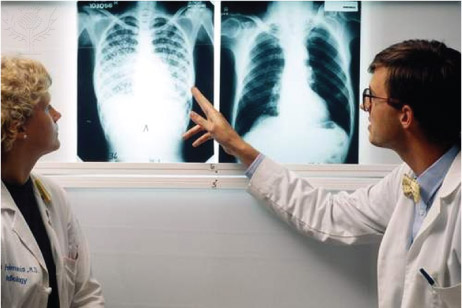3.8.2 Lower respiratory infections
Lower respiratory infections (LRIs) result in over 3 million deaths worldwide every year – more than any other category of infectious disease. Around one million of these deaths are due to pneumonia [nyoo-moh-nee-ah] caused by several species of bacteria and some viruses. The infection triggers inflammation in the lungs, which become clogged with infected fluid, resulting in severe breathing difficulties and strain on the heart.
Tuberculosis is counted separately from all other respiratory infections because the TB bacteria (Mycobacteria tuberculosis) that infect the lungs (Figure 15) can also invade other vital organs, muscles and bones. About one-third of the world’s population (over 2 billion people, i.e. two thousand million) is infected with TB bacteria, but most are unaware of it because the body’s defence mechanisms keep the bacteria in check. However, they can multiply if the body’s defences are weakened, and TB can quickly develop in undernourished people, especially if they have another illness.

Between 8 and 9 million people around the world develop TB for the first time every year, almost 9000 of them in the UK. Worldwide, this chronic infection killed 1.3 million (1 300 000) people in 2012 – a death toll that has been slowly increasing in the 21st century. The resurgence of TB and its increasing resistance to antibiotics means that it has been classified as a ‘re-emerging infectious disease’.
